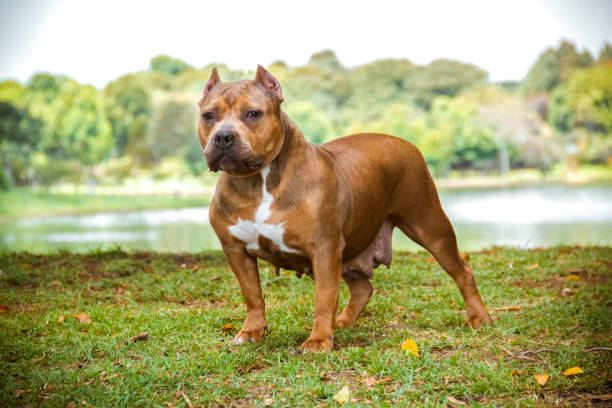Staffordshire Bull Terrier

Breed History:
The Staffordshire Bull Terrier, often affectionately known as the "Staffy," originated in 19th-century England. It was developed by crossing Bulldogs with various terriers to create a strong, agile dog used in blood sports such as bull-baiting and dog fighting. However, when such practices were banned, the breed transitioned into a loyal and affectionate family companion, particularly favoured by working-class families.
Despite its tough origins, the Staffordshire Bull Terrier gained a reputation for its affectionate nature and loyalty, especially toward children. It was recognised by The Kennel Club (UK) in 1935 and is now celebrated for its loving personality, courage, and intelligence.
|
Gender |
Height |
Weight |
|
Male |
36-41 cm |
13-17 kg |
|
Female |
33-38 cm |
11-15 kg |
Size – Medium
Life Expectancy: 12–14 years

Breed Appearance:
The Staffordshire Bull Terrier is a compact, muscular dog with a broad head, short muzzle, and pronounced cheek muscles. Its eyes are round and dark, conveying intelligence and alertness, while its ears are small and typically rose-shaped. The breed has a smooth, short coat that lies close to the body and comes in a variety of colours, including red, fawn, white, black, blue, and brindle, often with white markings.
Despite its robust and powerful appearance, the Staffy carries itself with agility and confidence. Its well-balanced frame and strong limbs support its reputation for strength and endurance.
Breed Type – Family/Guardian:
The Staffordshire Bull Terrier is renowned for its devotion to its family and is especially affectionate with children, so much so that it's nicknamed the “nanny dog” in the UK. It thrives on human interaction and is happiest when included in daily life. Though it has a protective streak, it is not aggressive by nature when properly socialised.
While typically friendly toward people, the breed may display assertiveness toward other dogs, particularly if untrained. With early socialisation and a confident owner, the Staffy can coexist peacefully with other pets.

Training:
The Staffordshire Bull Terrier is intelligent and eager to please, making it responsive to training when approached with positive reinforcement techniques. It learns quickly and enjoys engaging tasks, thriving on interaction and mental stimulation.
However, its strong will and enthusiastic energy may require consistent guidance and early socialisation. Staffies respond best to firm yet kind leadership, and they excel in obedience, agility, and even therapy work when given the chance. Harsh methods should be avoided, as the breed is sensitive and bonds deeply with its humans.
Health & Care:
Generally healthy, the Staffordshire Bull Terrier has a few breed-specific health concerns that owners should monitor:
-
Hereditary cataracts
-
Hip dysplasia
-
Patellar luxation
-
Skin allergies
-
L-2-HGA (a metabolic disorder; can be tested for)
Routine vet visits, proper diet, and moderate daily exercise will help maintain the breed’s health. Regular checks for skin issues, especially allergies, are advised due to their short coat and sensitivity.

Living Conditions:
Staffordshire Bull Terriers are adaptable and do well in various environments, from apartments to large homes, provided they receive enough exercise and interaction. They prefer to be close to their family and may experience separation anxiety if left alone for extended periods.
They require a secure, fenced yard if off-leash, as their strong prey drive and curiosity may lead them to wander. Due to their social nature, Staffies are not suited for outdoor-only living and thrive in homes where they are part of the daily routine.
Exercise:
This energetic and muscular breed needs daily exercise to remain mentally and physically healthy. Long walks, interactive play sessions, and training activities are ideal. Staffordshire Bull Terriers enjoy tug games, agility, and fetch, which cater to both their physical needs and desire to bond with their owner.
Though highly energetic, Staffies are also content to relax indoors with their family once their exercise needs are met. Mental enrichment is equally important, as boredom can lead to destructive behaviour.
Grooming:
The Staffordshire Bull Terrier has a low-maintenance coat that requires minimal grooming. Weekly brushing with a soft-bristle brush or rubber mitt will keep the coat shiny and remove loose hair. The breed is a moderate shedder, with heavier shedding typically occurring during seasonal changes.
Bathing should be occasional, using a gentle dog shampoo to avoid skin irritation. Nail trimming, ear cleaning, and regular dental care are essential parts of the grooming routine. Because of their short coat, Staffies may need a dog sweater during colder weather.

Advantages:
-
Affectionate, loyal, and great with children
-
Intelligent and eager to learn with positive training
-
Low grooming requirements
-
Compact size makes it suitable for urban living
-
Confident and courageous, yet friendly
-
Strong family bonds and protective instincts
Disadvantages:
-
Can be dog-aggressive if not socialised early
-
Needs regular physical and mental exercise
-
May suffer from separation anxiety if left alone too long
-
A short coat provides little protection from cold or sun
-
Not ideal for novice owners without time for proper training
-
May be subject to breed-specific legislation in some areas

